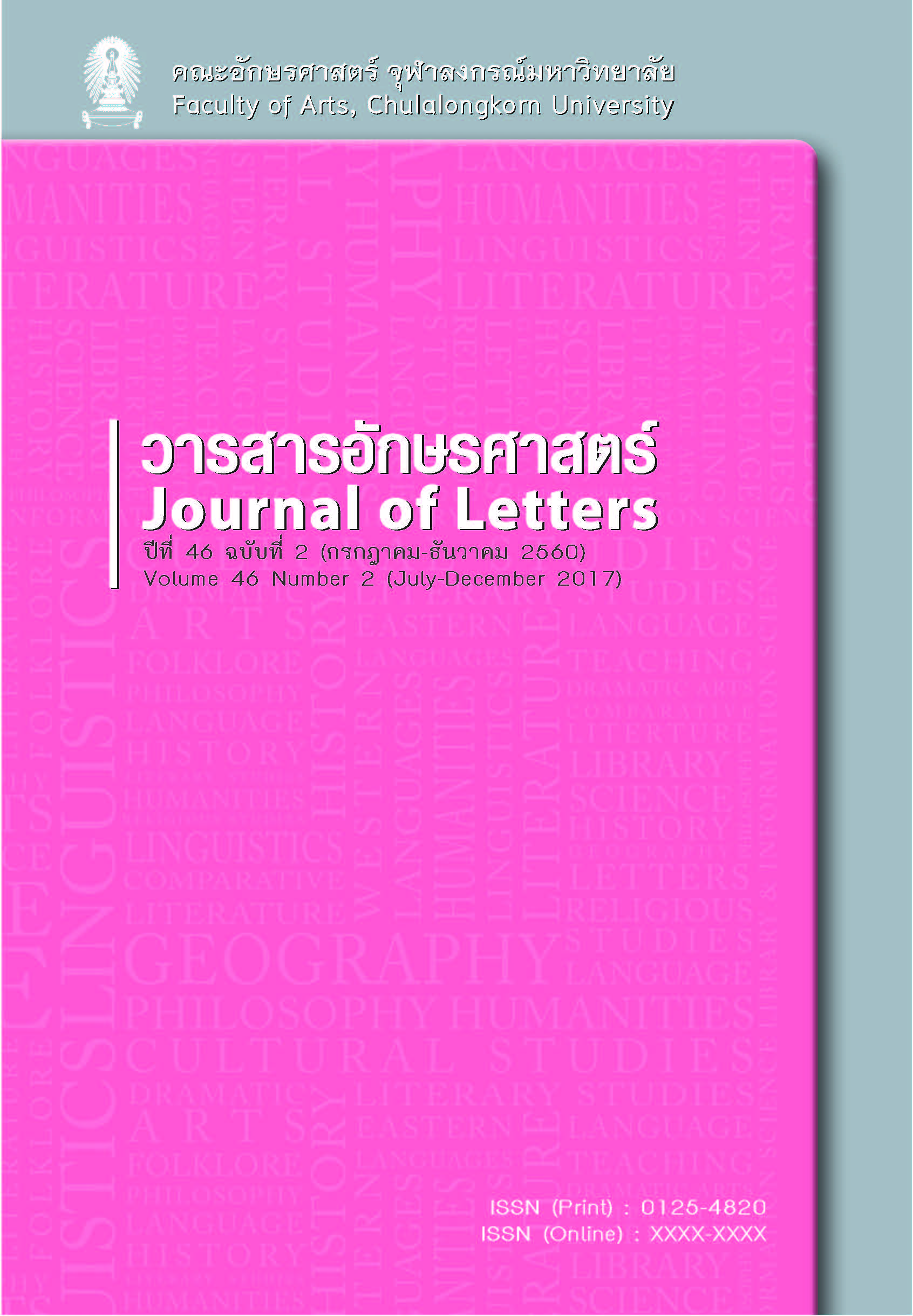The Semantics of the Preposition khɔ̌ɔŋ in Thai
Keywords:
Thai possessive marker, preposition, possession, nominal constructions, semantic relationsAbstract
It is known among Thai language users that the preposition khɔ̌ɔŋ in Thai is used to express possessive relations between two entities. The concept that readily comes to mind when the language users think about “possession” is ownership. However, there are other types of relations subsumed under linguistic possession expressed by the preposition khɔ̌ɔŋ. The purpose of this paper is, therefore, to identify the possible semantic relations between possessed nouns and possessor noun phrases in nominal constructions with the preposition khɔ̌ɔŋ in Thai. The 2,700 data were collected from the Thai National Corpus. It was found that the semantic relations expressed by the possessive marker khɔ̌ɔŋ could be divided into at least 7 types: 1) ownership, 2) body part relationships, 3) interpersonal relationships, 4) part-whole relations, 5) attributes-attribute holders, 6) predication-participant relations, and 7) whole-content relations.
References
Nanthakaa Paholayuth นันทกา พหลยุทธ. 1983. “Kansueksa priapthiap kanchai kham bupphabot nai samai sukhothai, ayutthaya kap samai patchuban” การศึกษาเปรียบเทียบการใช้คำบุพบทในสมัยสุโขทัย อยุธยา กับสมัยปัจจุบัน. [The Use of Prepositions in the Sukhothai, Ayudhya and Ratanakosin Periods: A Comparative Study]. Master thesis, Chulalongkorn University.
The Royal Institute, Thailand ราชบัณทิตยสถาน. 2013. Royal Institute Dictionary 2011 (2nd edition) พจนานุกรม ฉบับราชบัณฑิตยสถาน พ.ศ. 2554 (พิมพ์ครั้งที่ 2). Bangkok, The Royal Institute
Upakit Silapasan, Phraya (Nim Kanchanachiwa) พระยาอุปกิตศิลปสาร (นิ่ม กาญจนาชีวะ). 2005. Lak phasa thai หลักภาษาไทย: อักขรวิธี วจีวิภาค วากยสัมพันธ์ ฉันทลักษณ์ (พิมพ์ครั้งที่ 13) [Principles of the Thai Language] Bangkok, Thai Wattanaphanit.
Vichin Panupong วิจินตน์ ภาณุพงศ์. 1987. Khrongsang khong phasa thai (9th edition) โครงสร้างของภาษาไทย (พิมพ์ครั้งที่ 9) [The Structure of Thai]. Bangkok, Ramkhamhaeng University Press.
ภาษาอังกฤษ
Aikhenvald, Alexandra Y. 2013. Possession and Ownership: A Cross Linguistic Perspective. In Possession and Ownership: A Cross-Linguistic Typology, eds. A. Y. Aikhenvald and R. M. W. Dixon, 1-64. Oxford: Oxford University Press.
Aroonmanakun, W., Tansiri, K., & Nittayanuparp, P. 2009. Thai National Corpus: A Progress Report. Proceedings of the 7th Workshop on Asian Language Resources, ACL-IJCNLP 2009, 153-160). Suntec, Singapore, 6-7 August 2009.
Chaffin, R., & Herrmann, D. 2009. The Nature of Semantic Relations: A Comparison of Two Approaches. In Relational Models of the Lexicon: Representing Knowledge in Semantic Networks, ed. M. W. Evens, 289-334. New York: Cambridge University Press.
Diller, Anthony. 2001. Grammaticalization and Tai Syntactic Change. In Essays in Tai Linguistics, eds. M.R.K. Tingsabadh and A.S. Abramson, 139-175. Bangkok: Chulalongkorn University Press.
Dixon, Robert M. W. 2010. Basic Linguistic Theory: Grammatical Topics (Vol. 2). Oxford: Oxford University Press.
Enfield, Nick J. 2003. Linguistics Epidemiology: Semantics and Grammar of Language Contact in Mainland Southeast Asia. London: Routledge Curzon.
Heine, Bernd. 1997a. Cognitive Foundations of Grammar. New York: Oxford University Press.
Heine, Bernd. 1997b. Possession: Cognitive Sources, Forces and Grammaticalization. Cambridge: Cambridge University Press.
Herslund, M., & Baron, I. 2001. Introduction: Dimensions of Possession. In Dimensions of Possession, eds. I. Baron, M. Herslund and F. Sørensen, 1-25. Philadelphia: John Benjamins Publishing.
Huang, S.-Z., & Jenks, P. 2014. Nominal Modification in Chinese and Thai. Proceedings of the 31st West Coast Conference on Formal Linguistics, 227-237. Cascadilla Proceedings Project.
Langacker, Ronald W. 1995. Possession and Possessive Constructions. In Language and the Cognitive Construal of the World, eds. J. R. Taylor and R. E. MacLaury, 51-79. Berlin: Mouton de Gruyter.
Langacker, Ronald W. 2009. Investigations in Cognitive Grammar (Vol. 42). Berlin: Walter de Gruyter.
Luo, Yongxian. 2013. Possessive Constructions in Mandarin Chinese. In Possession and Ownership: A Cross-Linguistic Typology, eds. A. Y. Aikhenvald and R. M. W. Dixon, 186-207. Oxford: Oxford University Press.
Luraghi, Silvia. 2014. Plotting Diachronic Semantic Maps. In Perspectives on Semantic Roles (Vol. 106), eds. S. Luraghi and H. Narrog. Philadelphia: John Benjamins Publishing.
Miller, G. A., & Johnson-Laird, P. N. 1976. Language and Perception. Cambridge: Belknap Press.
Mitkovska, Liljana. 2004. The Conceptual Network of the Possessive na-construction in Macedonian. Glossos, 5: 1-22.
Nikiforidou, Kiki. 1991. The Meanings of the Genitive: A Case Study in Semantic Structure and Semantic Change. Cognitive Linguistics 2(2): 149-205.
Perniss, P., & Zeshan, U. 2008. Possessive and Existential Constructions: Introduction and Overview. Possessive and Existential Constructions in Sign Languages, 1-31. Nijmegen: Ishara Press.
Poutsma, Hendrik. 1914. A Grammar of Late Modern English, for the Use of Continental, especially Dutch, Students. Part II: The Parts of Speech (Section I, A: Nouns, Adjectives and Articles). Groningen: Noordhoff.
Quirk, R., Greenbaum, S., Leech, G., Svartvik, J., & Crystal, D. 1985. A Comprehensive Grammar of the English Language (Vol. 397). New York: Longman.
Rosenbach, Anette. 2008. Animacy and Grammatical Variation—Findings from English Genitive Variation. Lingua 118: 151-171.
Singnoi, Unchalee. 2000. Nominal Constructions in Thai. Doctoral Dissertation, University of Oregon.
Taylor, John R. 2007. Linguistic Categorization (3rd ed.). New York: Oxford University Press.
Tsujioka, Takae. 2002. The Syntax of Possession in Japanese. New York: Routledge Publishers.
van Valin, Robert D. 2004. An Introduction to Syntax. Cambridge: Cambridge University Press.
Winston, M. E., Chaffin, R., & Herrmann, D. 1987. A Taxonomy of Part-Whole Relations. Cognitive Science, 11: 417-444.
Downloads
Published
How to Cite
Issue
Section
License
Copyright and plagiarism
Authors are responsible for obtaining permission to use copyrighted materials from copyright owners. Authors are responsible for observing requisite copyright law when quoting or reproducing copyrighted materials. Quotations and reproductions of content from other published sources must be accompanied by a reference and all sources should be clearly listed in the references section. Quotations and reproductions of content from external sources without due attribution could be considered a severe infringement of academic conduct and may constitute a legal offence under the Copyright Act of B.E. 2537. Any legal ramifications arising from the infringement of copyright regulations would be the sole responsibility of the author(s).



